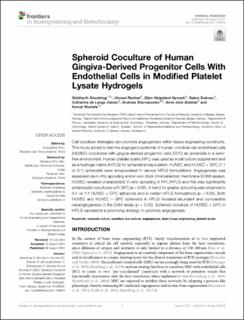Spheroid Coculture of Human Gingiva-Derived Progenitor Cells With Endothelial Cells in Modified Platelet Lysate Hydrogels
Shanbhag, Siddharth; Elsebahy, Ahmad Rashad; Helgeland Nymark, Ellen; Suliman, Salwa; Davies, Catharina de Lange; Stavropoulos, Andreas; Bolstad, Anne Isine; Mustafa, Kamal Babikeir Elnour
Journal article, Peer reviewed
Published version

Åpne
Permanent lenke
https://hdl.handle.net/11250/2988616Utgivelsesdato
2021-08-26Metadata
Vis full innførselSamlinger
Originalversjon
Frontiers in Bioengineering and Biotechnology. 2021, 9, 739225. 10.3389/fbioe.2021.739225Sammendrag
Cell coculture strategies can promote angiogenesis within tissue engineering constructs. This study aimed to test the angiogenic potential of human umbilical vein endothelial cells (HUVEC) cocultured with gingiva-derived progenitor cells (GPC) as spheroids in a xeno-free environment. Human platelet lysate (HPL) was used as a cell culture supplement and as a hydrogel matrix (HPLG) for spheroid encapsulation. HUVEC and HUVEC + GPC (1:1 or 5:1) spheroids were encapsulated in various HPLG formulations. Angiogenesis was assessed via in vitro sprouting and in vivo chick chorioallantoic membrane (CAM) assays. HUVEC revealed characteristic in vitro sprouting in HPL/HPLG and this was significantly enhanced in cocultures with GPC (p < 0.05). A trend for greater sprouting was observed in 5:1 vs 1:1 HUVEC + GPC spheroids and in certain HPLG formulations (p > 0.05). Both HUVEC and HUVEC + GPC spheroids in HPLG revealed abundant and comparable neoangiogenesis in the CAM assay (p > 0.05). Spheroid coculture of HUVEC + GPC in HPLG represents a promising strategy to promote angiogenesis.
